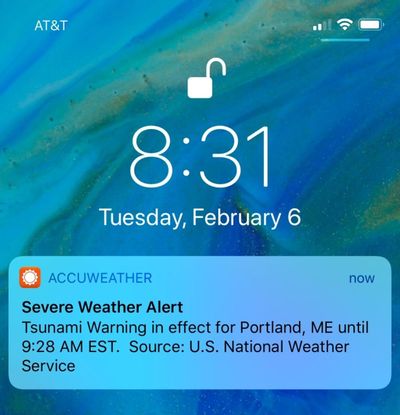AccuWeather, feds trade blame for bogus tsunami warning

A private forecasting company took what was intended to be a routine National Weather Service test message and sent it to subscribers’ phones as an official tsunami warning Tuesday morning, the latest in a spate of false alarms since last month.
AccuWeather blamed the National Weather Service for the false alarm, saying the government weather agency “miscoded” a test message as a real warning. The weather service rejected the claim. The back-and-forth only added to the confusion about why and how AccuWeather customers throughout the East Coast, the Gulf of Mexico and the Caribbean wound up with a tsunami warning that wasn’t real.
Jeremy DaRos, of Portland, Maine, said the alert made him “jump” because he lives a stone’s throw from the water and was aware of recent spate of small earthquakes that made the alert seem plausible.
“Looking out the window and seeing the ocean puts you in a different frame of mind when you get a tsunami warning,” DaRos said. He said he realized it was just a test after clicking on the push notification for details.
The National Tsunami Warning Center sent the routine monthly test message around 8:30 a.m. EST Tuesday, which AccuWeather then pushed to mobile devices as a real tsunami warning. The Weather Channel said its users also saw the bogus warning on the company’s mobile app and website for about an hour, though it wasn’t sent as a push notification.
The word “TEST” appeared in the header of the government agency’s message, but State College, Pennsylvania-based AccuWeather said it automatically passes along weather service warnings based on a computer scan of codes, with no human input.
“Tsunami warnings are especially time sensitive given the fact that people may have only minutes to react to a tsunami threat,” said Jonathan Porter, AccuWeather’s vice president of business services. “As such, we process them with the utmost concern and deliver them promptly and automatically as soon as they’re received by the government.”
AccuWeather said its systems worked as intended.
“AccuWeather was correct in reading the mistaken NWS codes embedded in the warning. The responsibility is on the NWS to properly and consistently code the messages, for only they know if the message is correct or not,” the company said in a statement.
Hours later, weather service spokeswoman Susan Buchanan said the agency’s investigation found the test message was properly coded.
The weather service is “working with private sector companies to determine why some systems did not recognize the coding,” she said in a statement. “Private sector partners perform a valuable service in disseminating warnings to the public. We will continue to work with our partners to prevent this from occurring again.
AccuWeather CEO Barry Myers had warned the weather service about incorrectly coded emergency messages after a similar problem in 2014. Myers, who co-founded AccuWeather, is now President Donald Trump’s pick to head the government agency that oversees the weather service.
Tuesday’s false alert didn’t create nearly as much panic as last month’s bogus ballistic missile warning in Hawaii. The state employee who sent the alert was fired.
Also last month, a malfunction triggered sirens at a North Carolina nuclear power plant.